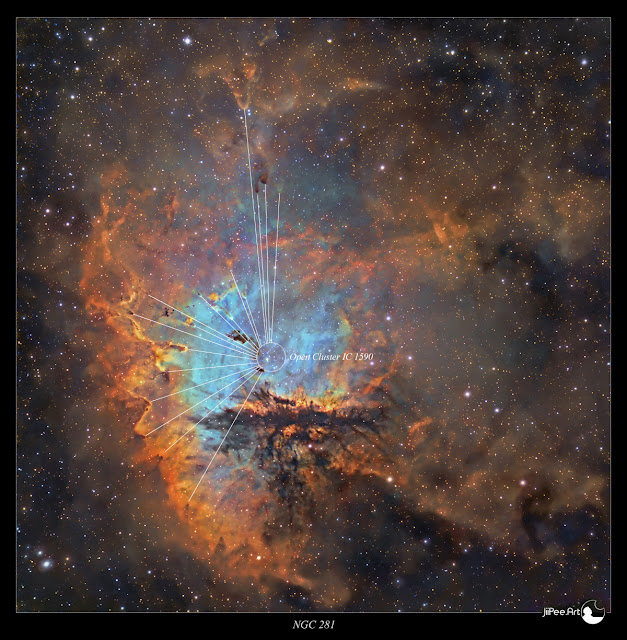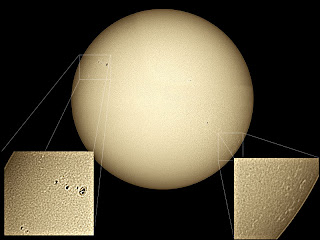COPYRIGHT, PLEASE NOTE
Saturday, January 4, 2025
New photo of NGC 281
Deep view to the NGC 281
Click for a full size, 2700x2500 pixels
The seeing wasn't very good so I couldn't quite split the two of the stars but it can be seen, that there are two stars very close to each other visually.
sulfur=red, hydrogen=red and oxygen=blue, this combination is very close to a natural color palette.
INFO
NGC 281 is a busy workshop of star formation. Prominent features include a small open cluster of stars, a diffuse red-glowing emission nebula, large lanes of obscuring gas and dust, and dense knots of dust and gas in which stars may still be forming. The open cluster of stars IC 1590 visible around the center has formed only in the last few million years. The brightest member of this cluster is actually a multiple-star system shining light that helps ionize the nebula's gas, causing the red glow visible throughout. The lanes of dust visible below the center are likely homes of future star formation. Particularly striking in the above photograph are the dark Bok globules visible against the bright nebula. Stars are surely forming there right now. The entire NGC 281 system lies about 10 thousand light years distant. (Source, NASA APOD)
With my new imaging system I can get deeper with a good resolution, than my old long focal length toolset was able to. The secondary mirror focusing system takes care of focusing and temperature compensation, I can keep the heavy main mirror locked down all the time. Heavy mirror has a tendency to move a bit when the scope moves and that can mess up the collimation.
The current system keeps collimation perfect all the time.
An other great accessory is the Active Optics Unit from Starlight Xpress. It's as easy to use as any OAG, the good update speed to a 11 mag star is around 8Hz. The AO-unit removes all the minor tracking errors very fast. The Mesu Mount Mark II has a periodic error under four arcseconds and that's a very small error, even so, AO unit gives a better image quality since the corrections are made by moving a light weight piece of glass, the heavy load of the scope and accessories doesn't need to move for corrections.
Structure study of the NGC 281
 Pillar like formations in the gas cloud are forming when the radiation pressure (Solar Wind) from the open cluster IC 1590 blows the gas and dust away and coursing some parts of the gas collapse.Due to that, they all are pointing to the source of the solar wind, open cluster IC 1590, as I have shown in the image above.
Pillar like formations in the gas cloud are forming when the radiation pressure (Solar Wind) from the open cluster IC 1590 blows the gas and dust away and coursing some parts of the gas collapse.Due to that, they all are pointing to the source of the solar wind, open cluster IC 1590, as I have shown in the image above.Please, click for a large image
O-III,9x 1200 s, binned 2x2 = 3h
A single calibrated 20 min exposure of H-alpha, Bin 1x1
Monday, December 31, 2007
Planetary images from 2004-2006
 Jupiter
Jupiter Our Sun with few tiny Sun spots
Our Sun with few tiny Sun spots
 Venus
Venus
 An other Saturn image
An other Saturn image

















